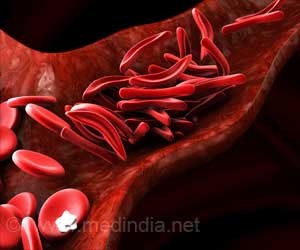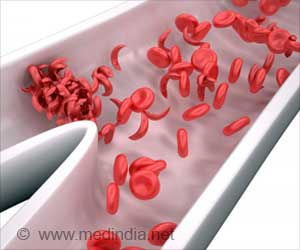Being a carrier of sickle cell disease raises the risk of blood clots across diverse populations, according to NIH research.

Ancestry-Independent Comparative Risk of Venous Thromboembolism in Individuals with Sickle Cell Trait vs. Factor V Leiden
Go to source).
‘ Did You Know?
Sickle cell disease affects around 100,000 people in the United States, with most cases found in individuals of African descent. #sicklecelldisease #bloodclots ’





The study provides estimated clinical risks for people with sickle cell trait, which can inform clinical practice guidelines. Sickle cell disease affects around 100,000 people in the United States, with most cases found in individuals of African descent. #sicklecelldisease #bloodclots ’
Researchers examined the largest and most diverse set of people with sickle cell trait to date, which includes data from over 19,000 people of various ancestral backgrounds with sickle cell trait.
The study was led by researchers at the National Human Genome Research Institute (NHGRI), part of NIH, The Johns Hopkins University School of Medicine, Baltimore, and the company 23andMe, South San Francisco, California.
Previous research investigating the relationship between sickle cell trait and blood clots has only included individuals of African genetic ancestry and self-identified Black participants because of the incorrect assumption that the genetic carrier state only affects those who identify as Black or African American.
While sickle cell trait in the United States is most prevalent in individuals who self-identify as Black or African American, individuals from all ancestral backgrounds may have sickle cell trait.
Advertisement
“Because sickle cell trait is often associated with people who identify as Black or African American, it is not widely studied in other populations, a bias that has led to unintended harm for those with sickle cell trait,” says Vence Bonham Jr., J.D., who co-led the study and serves as acting deputy director and associate investigator at NHGRI.
Advertisement
A Genetic Risk Across All Ancestries
Individuals in this study are part of the 23andMe research program and have volunteered to participate in the research online and provided informed consent, which includes allowing their de-identified data to be analyzed and subsequently shared with research collaborators.Using data from this research cohort, which consists of over four million participants, researchers calculated the risk of blood clots in the veins, also known as venous thromboembolism.
Through statistical analyses, participants were grouped based on their genetic similarities into genetic ancestry groups.
The study found that people with sickle cell trait have a 1.45-fold higher risk of venous thromboembolism than those without sickle cell trait, a risk that is similar across all studied genetic ancestry groups.
To help clinicians estimate the risk of blood clots in people with sickle cell trait in comparison to other genetic carrier states, the researchers analyzed risk in people who are carriers for Factor V Leiden, a well-known inherited blood clotting disorder.
The study found that carriers for Factor V Leiden, which is more prevalent in people of European genetic ancestries, had an even higher risk of venous thromboembolism than people with sickle cell trait.
The researchers found that people with sickle cell trait have a higher risk of a type of blood clot called pulmonary embolism than those without sickle cell trait.
Pulmonary embolism occurs when a blood clot breaks loose from deep veins, travels through the bloodstream, reaches the lungs, and stops blood flow. While people who experience pulmonary embolism may not always have symptoms, they might experience shortness of breath, chest pain, and fainting.
While previous studies have demonstrated that in individuals with sickle cell trait, the risk of blood clots occurring in the lungs is higher than the risk of clots occurring only in the legs, this study supports the link more definitively with a larger sample size.
“This study, therefore, provides important insights about patterns of venous blood clots and suggests a unique mechanism of blood clotting in people with sickle cell trait,” said Rakhi Naik, M.D., clinical director for the Division of Hematology at Johns Hopkins University, Baltimore, who co-led the study.
“Knowing the risks of blood clots in people with sickle cell trait is important for situations such as surgeries or hospitalizations, which add to the risk of developing serious blood clots.”
Reference:
- Ancestry-Independent Comparative Risk of Venous Thromboembolism in Individuals with Sickle Cell Trait vs. Factor V Leiden - (http://dx.doi.org/10.1182/bloodadvances.2024014252)
Source-Eurekalert














